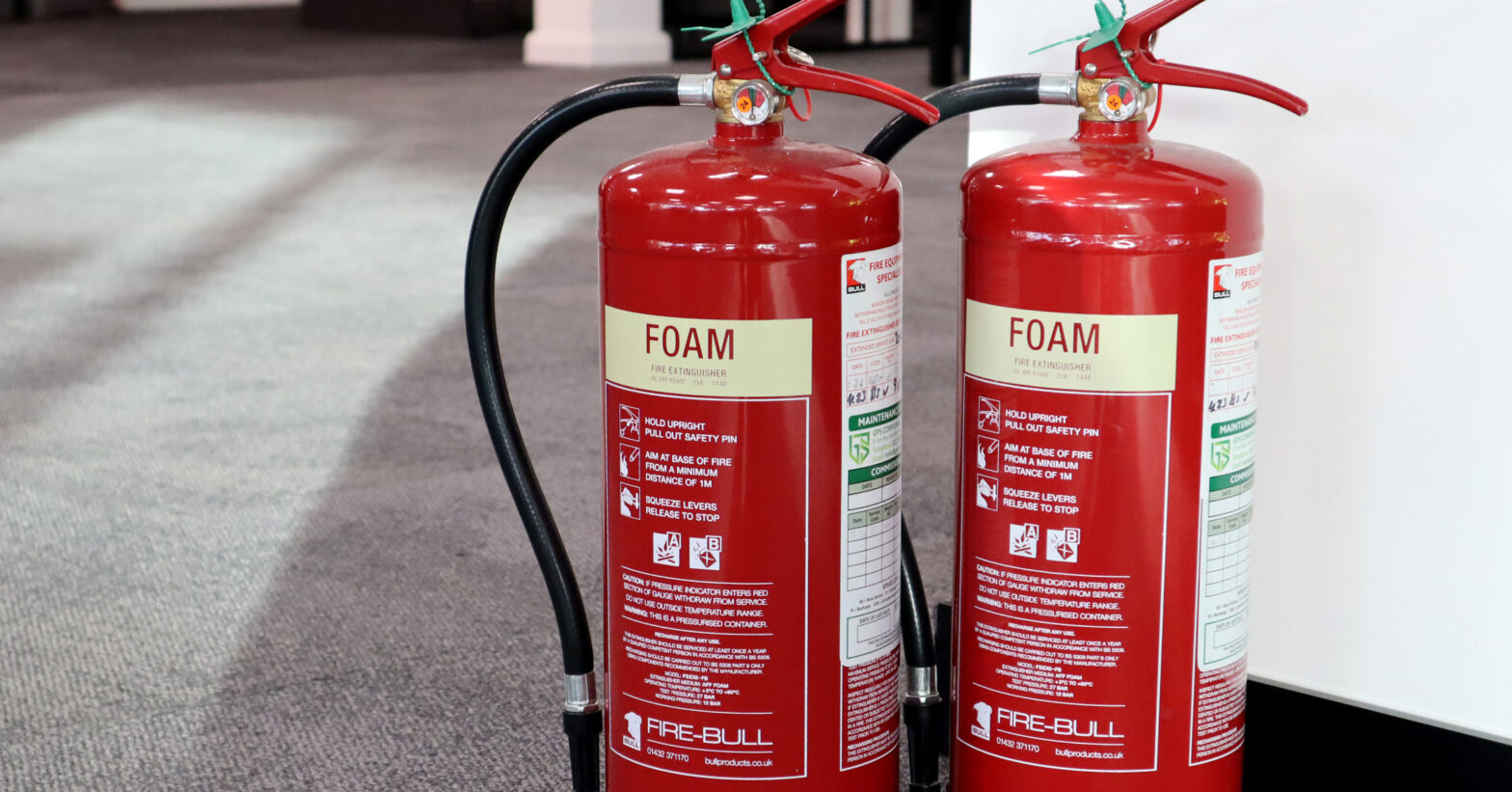
Fire safety regulations in the UK are evolving, with a significant upcoming change being the total ban on Aqueous Film Forming Foam (AFFF) fire extinguishers by 4 July 2025. For decades, AFFF has been widely used for suppressing fires involving flammable liquids and solids, but environmental and health concerns have led to its phase-out. At Stronghold Global, we’re here to help you understand the reasons behind this shift, the dangers of AFFF, and the practical steps your organisation should take to switch to safer, compliant alternatives.
Why is AFFF Firefighting Foam Hazardous?
AFFF fire extinguishers have traditionally been used to combat Class B (flammable liquid) fires and, in some cases, Class A (flammable solid) fires. However, AFFF contains toxic chemicals, notably Perfluorooctanoic Acid (PFOA) and other Polyfluoroalkyl Substances (PFAS), commonly known as “forever chemicals” because of their extreme persistence in the environment.
PFAS compounds do not degrade easily; they dissolve quickly in water, contaminating soil, waterways, and drinking water supplies. From there, they can enter the food chain, creating widespread environmental issues that are difficult to reverse. As these chemicals accumulate in living organisms over time, the potential for harm grows, affecting ecosystems and human health.
Health Risks Associated with PFAS
PFAS chemicals can build up in the bodies of animals and humans over time and are linked to a range of serious health issues. Known health risks include liver and kidney disease, reduced fertility, immune system suppression, cardiovascular issues, and various cancers. Research by the European Chemicals Agency (ECHA) and other health bodies highlights the significant dangers of PFAS exposure, underscoring the importance of regulatory action to limit its spread.
How is the UK Phasing Out AFFF Fire Extinguishers?
The process to phase out AFFF began in May 2019 when PFOA was added to the Persistent Organic Pollutants (POPs) Regulation. Since July 2020, selling AFFF extinguishers containing PFOA in the UK has been illegal, and their use in training exercises has been prohibited. While existing AFFF stocks can be used until 4 July 2025, this is strictly regulated. Businesses using AFFF extinguishers must follow specific containment and disposal procedures, including notifying the Environmental Protection Agency (EPA) of their use.
After 4 July 2025, all AFFF extinguishers must be decommissioned and safely disposed of through certified hazardous waste disposal services. Compliance with these regulations is essential, as improper disposal can result in severe environmental damage and legal consequences.
Safer Alternatives to AFFF Fire Extinguishers
The AFFF ban means businesses must start transitioning to safer fire extinguishing options. The following alternatives are effective and environmentally friendly, making them suitable replacements for AFFF.
For Class A Fires (Combustible Solids)
- Water Extinguishers: Simple and effective, water extinguishers are ideal for most common fires involving wood, paper, and other solid combustibles.
- Water Mist Extinguishers: A versatile, eco-friendly solution suitable for Class A, B, and C fires, as well as fires involving electrical equipment. Water mist extinguishers release ultra-fine droplets that cool and suffocate flames without causing damage or leaving residue.
- Wet Chemical Extinguishers: Designed for fires involving cooking oils and fats, these are effective in commercial kitchens and food preparation areas.
- Dry Powder Extinguishers: Suitable for multiple types of fires, though they require specific health and safety considerations if used indoors due to the powder’s potential respiratory effects.
For Class B Fires (Flammable Liquids)
- Fluorine-Free Firefighting Foam (F3): A fluorine-free alternative that forms a protective layer over flammable liquids, effectively preventing vapour release and extinguishing flames. It’s an environmentally friendly option suitable for most Class B fire risks.
- Dry Chemical Agents: These agents, which include compounds like sodium bicarbonate, potassium bicarbonate, and mono ammonium phosphate, work by interrupting the fire’s chemical reaction, smothering the flames.
- C6 Firefighting Foam: While still containing PFAS, C6 foams consist of shorter-chain compounds that break down more quickly in the environment. Although less harmful than AFFF, the EPA continues to scrutinise its safety, making it a potential but temporary solution.
- Water Mist Extinguishers: Offering a non-toxic, residue-free option, water mist extinguishers are suitable for a wide range of fires, including those involving flammable liquids and electrical equipment. This versatile solution is ideal for environments that require rapid and clean fire suppression.
Consider the P50 Fire Extinguisher
For businesses seeking a highly effective and low-maintenance option, the P50 fire extinguisher is a great alternative. This unique extinguisher is suitable for Class A and Class B fires and is made from corrosion-resistant materials, requiring only visual inspections. Unlike traditional extinguishers, the P50 does not need annual servicing by external professionals, significantly reducing maintenance costs. With a 10-year lifespan, the P50 provides reliable protection, making it a sustainable investment that aligns with new safety standards.
Preparing for the Change
With the upcoming AFFF ban, organisations should act now to ensure their fire safety equipment is compliant. Here’s a checklist to help prepare:
1. Conduct a Fire Safety Assessment: Review all fire safety equipment to identify and phase out any AFFF foam extinguishers currently in use.
2. Plan for Disposal: Arrange for proper disposal of AFFF extinguishers through a licensed hazardous waste disposal company, as improper handling could lead to environmental contamination and regulatory penalties.
3. Transition to Safer Alternatives: Explore suitable replacements for AFFF, such as water mist, fluorine-free foam, or P50 extinguishers, to maintain effective and compliant fire protection.
4. Schedule Staff Training: Ensure all personnel are familiar with the new fire safety equipment, its applications, and safety protocols.
5. Monitor Compliance: Keep up-to-date with regulations to ensure your business complies with fire safety standards.
Stronghold Global: Your Fire Safety Partner
At Stronghold Global, we understand the challenges of navigating regulatory changes and maintaining a safe environment. Our fire safety experts are here to guide you through the transition and ensure compliance. Contact us today to find out how we can support your business in making this shift seamlessly, with the peace of mind that your fire safety equipment is compliant, effective, and environmentally responsible.




![stronghold global logo[94]](https://www.strongholdglobal.com/wp-content/uploads/2022/03/Stronghold-Global-Logo94.png)




